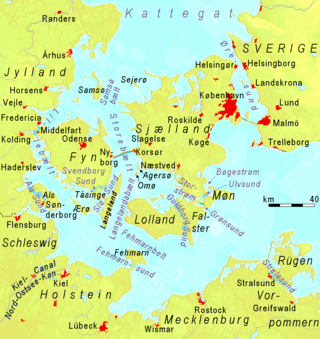Øresund

Øresund or The Sound (Danish: Øresund, Swedish: Öresund) is the strait that separates the Danish island Zealand (Danish: Sjælland) from the southern Swedish province of Scania (Swedish: Skåne). Its width is just 4 km at the narrowest point between Elsinore, Denmark and Helsingborg, Sweden.
Øresund is one of the three Danish Straits that connects the Baltic Sea to the Atlantic Ocean via Kattegat, Skagerrak, and the North Sea, and is one of the busiest waterways in the world.
The Øresund Bridge was inaugurated on July 1, 2000 by King Carl XVI Gustav of Sweden and Queen Margrethe II of Denmark. Between Helsingborg and Elsinore in the North of Øresund there are still ferries departing around the clock.
Contents |
History
Political control of Øresund has been an important issue in Danish and Swedish history. Denmark maintained military control with the coastal fortress of Kronborg at Elsinore on the west side and Kärnan at Helsingborg on the east, until the eastern shore was ceded to Sweden in 1658. Both fortresses are located where the strait is just 4 kilometers wide.
Sound Dues

In 1429 King Eric of Pomerania introduced the Sound Dues (Danish: Øresundstolden, Swedish: Öresundstullen) Transitory dues on the use of waterways, roads, bridges and crossings were then an accepted way of taxing which could constitute a great part of a state's income.
All foreign ships passing through the strait, whether en route to or from Denmark or not, had to make a stop in Helsingør and pay a toll to the Danish Crown. If a ship refused to stop, cannons in both Helsingør and Helsingborg could open fire and sink it. In 1567, the toll was changed into a 1-2% tax of the cargo value, providing three times more revenue. In order to avoid ships simply taking a different route, tolls were also collected at the two other Danish straits, the Great Belt and the Little Belt.
The Sound Dues remained the most important source of income for the Danish Crown for several centuries, thus making Danish kings relatively independent of Denmark's Privy Council and aristocracy. After 1658, when the Danish lands on the Scandinavian peninsula were ceded to Sweden, the toll could not be enforced as well as before but Denmark retained its established right of the dues. Sweden had been exempted from the dues from the start, as it was then part of the Kalmar Union with Denmark, but this was ended after the Great Northern War of 1720, although the eastern shore was now Swedish.
The Copenhagen Convention of 1857 abolished the dues and all Danish Straits were made international waterways free to all military and commercial shipping. It had been increasingly evident that the Sound Dues had a negative impact on the port and merchants of Copenhagen, although the dues delivered by then one eighth of the Danish state income. In compensation for the abolition, the Danish state received a one-time fee of 33.5 million Danish rigsdalers. [1]

Notable islands
- Amager
- Saltholm
- Ven
- Peberholm - an artificial island
- Middelgrundsfortet - an artificial island
- Flakfortet - an artificial island
See also
- Øresund Bridge
- Øresund Region
- Danish straits
- Great Belt
- Øresund station on the Copenhagen Metro
References
- Menefee, Samuel Pyeatt, "The Sound Dues and Access to the Baltic Sea" in Renate Platzoder and Philomene Verlaan (eds.), The Baltic Sea: New Developments in National Policies and International Co-Operation (1996), pp. 101-32.
External links
- Øresunddirekt - Official public information site for the inhabitants of the Øresund region